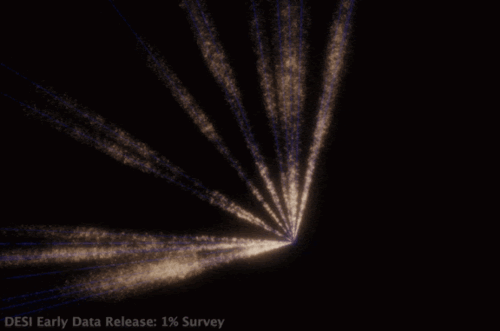
The Dark Energy Spectroscopic Instrument (DESI) is designed to create a 3-D map of the sky that will allow researchers to measure the effects of dark energy on the expansion of the universe. The Yale Fiberview Camera, designed, built, and installed by a team at Wright Lab, is an integral part of the efficiency and precision of DESI.
DESI recently released 80 terabytes of data from the experiment’s “survey validation” phase that includes nearly two million objects, including distant galaxies and quasars as well as stars in our own Milky Way. The data has already led to a set of papers, which include early measurements of galaxy clustering, studies of rare objects, and descriptions of the instrument and survey operations; as well as showing DESI’s ability to accomplish its design goals.
“The fact that DESI works so well, and that the amount of science-grade data it took during survey validation is comparable to previous completed sky surveys, is a monumental achievement,” said Nathalie Palanque-Delabrouille, co-spokesperson for DESI and a scientist at the Department of Energy’s Lawrence Berkeley National Laboratory (Berkeley Lab), which manages the experiment. “This milestone shows that DESI is a unique spectroscopic factory whose data will not only allow the study of dark energy but will also be coveted by the whole scientific community to address other topics, such as dark matter, gravitational lensing, and galactic morphology.”
The Yale Fiber View Camera
DESI uses 5,000 robotic positioners to move optical fibers that capture light from objects millions or billions of light-years away. It is the most powerful multi-object survey spectrograph in the world, able to measure light from more than 100,000 galaxies in one night. That light tells researchers how far away an object is, building a 3D cosmic map.
DESI’s Yale Fiberview Camera helps provide feedback for the robotic positioners so they can be precisely positioned in a very short amount of time. With changes of targets every 20 minutes, it is crucial that as little time be lost in moving to new targets as is possible, and the Yale Fiberview Camera enables the efficiency of the whole system.
Wright Lab’s Charlie Baltay, Eugene Higgins Professor Emeritus of Physics; David Rabinowitz, senior research scientist in physics; Terry Girard, research scientist in astronomy; William Emmett, senior mechanical engineer; Tom Hurteau, Wright Lab research and development technician; and a number of undergraduate research assistants designed, built and installed the Yale Fiberview Camera for DESI.
The Wright Lab team also engineered and built self-illuminated light sources that are mixed in with the fibers in the DESI focal plane. These are used to calibrate the Fiberview Camera and to relate its fiber measurements to on-sky target coordinates.
Rabinowitz said, “Yale’s Fiberview Camera is a vital part of the DESI spectrograph. None of the 5,000 fibers in the spectrograph would move on target without the camera. So it is partly the engineering and research efforts at Yale that have made DESI a success.”
Part of this article was adapted from a press release, “DESI Early Data Release Holds Nearly Two Million Objects,” by Lauren Biron published on June 13, 2023.

